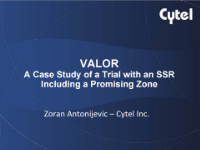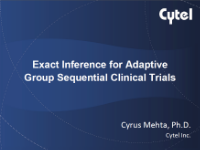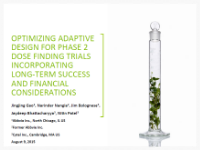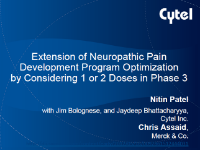
VALOR - A Case of a Trial with an SSR including a Promising Zone
 The unblinded sample size re-assessment (ubSSR) has been categorized as a "less-well understood" type of adaptive design in the CDER/CBER draft guidance on adaptive design. There has been, however, an increase in application of this type of design since the publication of this guidance. In this talk we will present selected case studies of trials using the uSSR. The presentation will address trial designs, regulatory interactions and operational challenges.
The unblinded sample size re-assessment (ubSSR) has been categorized as a "less-well understood" type of adaptive design in the CDER/CBER draft guidance on adaptive design. There has been, however, an increase in application of this type of design since the publication of this guidance. In this talk we will present selected case studies of trials using the uSSR. The presentation will address trial designs, regulatory interactions and operational challenges.Other Recent Work
Zoran Antonijevic and fellow experts address the impact of study design on maximizing output at the level of pharmaceutical portfolios. This is the only book on the market which examines the critical issues of portfolio optimization by integrating input from multiple development stakeholders. The result is an integrated approach that considers value propositions earlier by incorporating marketing, commercial and medical perspectives.
Exact Inference for Adaptive Group Sequential Clinical Trials
 Methods for controlling the type-1 error of an adaptive group sequential trial were developed in seminal papers by Cui, Hung and Wang, Lehmacher and Wassmer, and Muller and Schafer. However, corresponding solutions for the equally important and related problem of parameter estimation at the end of the adaptive trial have not so far been completely satisfactory. In this paper a method is provided for computing a two sided confidence interval having exact coverage, along with a point estimate that is median unbiased, for the primary efficacy parameter in a two arm adaptive group sequential design. The possible adaptations are not confined to sample size alterations but also include data dependent changes in the number and spacing of interim looks and changes in the error spending function. The procedure is based on mapping the final test statistic obtained in the modified trial into a corresponding backward image in the original trial.
Methods for controlling the type-1 error of an adaptive group sequential trial were developed in seminal papers by Cui, Hung and Wang, Lehmacher and Wassmer, and Muller and Schafer. However, corresponding solutions for the equally important and related problem of parameter estimation at the end of the adaptive trial have not so far been completely satisfactory. In this paper a method is provided for computing a two sided confidence interval having exact coverage, along with a point estimate that is median unbiased, for the primary efficacy parameter in a two arm adaptive group sequential design. The possible adaptations are not confined to sample size alterations but also include data dependent changes in the number and spacing of interim looks and changes in the error spending function. The procedure is based on mapping the final test statistic obtained in the modified trial into a corresponding backward image in the original trial.Other Recent Work
 Designs for Clinical Trials - Perspectives on Current Issues (Springer, 2012)
Designs for Clinical Trials - Perspectives on Current Issues (Springer, 2012)
This book examines current issues and controversies in clinical trial design, including topics in adaptive and group sequential designs and the design of studies in which missing data is anticipated. In the his chapter, Cyrus examines the process of identifying the optimal application of adaptive sample size re-estimation methodology. The result serves as a guidebook for today's statistician engaged in trial design.
 The accelerated use of adaptive design in clinical trials has provided drug research and development a more flexible and effective approach to better distribute resources and fitting patients' needs. Nevertheless, the extensive adaptive design research mainly focuses on the logistics of the trial itself lacking the global view which should incorporate both drug innovation and finance considerations. In this paper, we compare the adaptive design to the traditional fixed sample size design for phase 2 dose finding trials to optimize Net Present Value (NPV) for a drug via simulations of a single Phase 2 trial followed by 2 phase 3 trials. Results demonstrate that the adaptive design not only requires smaller sample size with higher probability of success in a phase 3 study, but also produces higher expected NPV than the fixed design in the long run.
The accelerated use of adaptive design in clinical trials has provided drug research and development a more flexible and effective approach to better distribute resources and fitting patients' needs. Nevertheless, the extensive adaptive design research mainly focuses on the logistics of the trial itself lacking the global view which should incorporate both drug innovation and finance considerations. In this paper, we compare the adaptive design to the traditional fixed sample size design for phase 2 dose finding trials to optimize Net Present Value (NPV) for a drug via simulations of a single Phase 2 trial followed by 2 phase 3 trials. Results demonstrate that the adaptive design not only requires smaller sample size with higher probability of success in a phase 3 study, but also produces higher expected NPV than the fixed design in the long run.Other Recent Work

Practical Considerations for Adaptive Trial Design and Implementation (Springer, 2014)
This volume is a definitive text on adaptive clinical trial designs from creation and customization to utilization. Nitin Patel and Jim Bolognese of Cytel each contribute key chapters, joining fellow authorities including FDA/CDER's Sue-Jane Wang. Covering the full spectrum of topics involved in the adaptive designs arena, this volume serves as a valuable reference for researchers working in industry, government and academia.
Extension of Neuropathic Pain Development Program Optimization by Considering 1 or 2 Doses in Phase 3
 In past work we have shown the value of program level optimization of Phase 2 and Phase 3 clinical trial designs for neuropathic pain (Patel N et.al. 'Designing Phase 2 Trials Based on Program-Level Considerations: A Case Study for Neuropathic Pain', Drug Information Journal, 2012, 46 (4) 439-454). The objective in that publication was to maximize Expected Net Present Value (ENPV) of the program while taking into account both efficacy and safety considerations. In this talk we will discuss extensions of that work to carrying two doses into Phase 3 when Phase 2 results indicate sufficient separation in efficacy between them in addition to meeting efficacy and safety targets. We consider situations where results may require additional Phase 3 programs for regulatory approval to enable taking two doses to market. In addition to the objective of maximizing ENPV we examine optimization with the objective of maximizing clinical utility.
In past work we have shown the value of program level optimization of Phase 2 and Phase 3 clinical trial designs for neuropathic pain (Patel N et.al. 'Designing Phase 2 Trials Based on Program-Level Considerations: A Case Study for Neuropathic Pain', Drug Information Journal, 2012, 46 (4) 439-454). The objective in that publication was to maximize Expected Net Present Value (ENPV) of the program while taking into account both efficacy and safety considerations. In this talk we will discuss extensions of that work to carrying two doses into Phase 3 when Phase 2 results indicate sufficient separation in efficacy between them in addition to meeting efficacy and safety targets. We consider situations where results may require additional Phase 3 programs for regulatory approval to enable taking two doses to market. In addition to the objective of maximizing ENPV we examine optimization with the objective of maximizing clinical utility.Other Recent Work

Practical Considerations for Adaptive Trial Design and Implementation (Springer, 2014)
This volume is a definitive text on adaptive clinical trial designs from creation and customization to utilization. Nitin Patel and Jim Bolognese of Cytel each contribute key chapters, joining fellow authorities including FDA/CDER's Sue-Jane Wang. Covering the full spectrum of topics involved in the adaptive designs arena, this volume serves as a valuable reference for researchers working in industry, government and academia.
Copyright © 2015 Cytel. All rights reserved